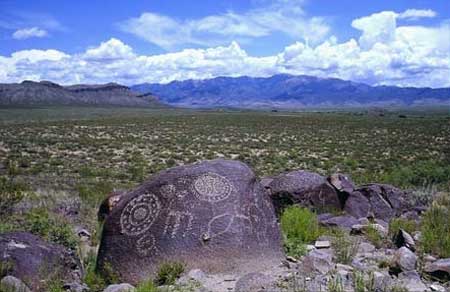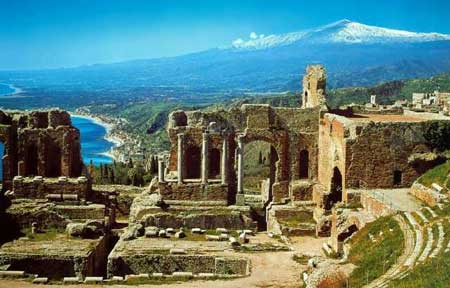VintageTexas Sunday ‘Cyclopedia of Wine: What do Sicily and Texas Have in Common?
Sicily, the largest of the Mediterranean islands, is one of the top three wine regions of Italy. Historically, its most famous wine was the amber fortified Marsala. Once the Sicilian wines were heavy, high in alcohol and sold in bulk or for blending (for addition of color to wines from central and northern Italy). The planting of new vineyards and implementation of new winemaking techniques have evolved Sicilian wines to new levels of quality.
Sicily today has some of the world’s most modern wineries, with the latest technology (e.g. temperature controlled fermentation) for making wine in a searing hot, dry summer climate. This has required considerable financial investment to build and equip the wineries, and to entice and train talented agronomists and winemakers. The region’s current success is the direct result of all this effort.
Sicilian grape varieties include some of the same varieties that we now find doing well in Texas. They include Moscato, Malvasia Bianco and Trebbiano as the whites, Nero d’Avola (also called Calabrese) and Primotivo are the reds.
Nero D’Avola is an interesting case study. In Sicily, it now can be sampled as a standalone varietal wine or blended with other varietals such as Merlot, Cabernet, and now days most often with Syrah. In Texas, we only have small plantings as yet, but it makes some interesting and rustic wines and has been used in blends with Barbera and Syrah.
Other Sicilian grape varietals that might like a chance to take to the Texas terroir include the following list of grape names that you likely will not recognize:
Carricante (Catanese Bianco). A white from the Etna area.
Cataratto Bianco. A white traditional in the Trapani area and used in Marsala wine, characterised by a delicate flavor and medium alcohol level.
Corinto. A light white.
Frappato. Strong red of uncertain origin grown in southeastern Sicily. It is genetically very similar to Gaglioppo.
Gaglioppo. A red of Calabrian origin frequently grown in Sicily. Similar to Frappato.
Grecanico (Greco). A white so-called for its Greek origins. Genetically very similar to the Garganega grown in Veneto.
Grillo. A distinctive white.
Inzolia, Insolia or Anzolia. Used to create dry white table wines, either as a varietal or blended with varieties such as chardonnay.
Nerello. Strong red grown in two varieties, Mascalese and Cappuccino.
Perricone (Pignatello). Esoteric, robust red.
Zibibbo (Moscatellone). White (a variety of Muscat of Alexandria)
Come on Texas Winegrowers, you might want to give them a try. You don’t know what might take root in the strong Texas sun.
— — — — —
Alas, we don’t have the Roman and Greek ruins and a Mediterranean vista. However, in Texas we do have ruins of ancient Native American civilizations and picturesque dessert and mountain vistas (See below).




Sicily one of the top 3 Italian wine regions? I think you’d have some Italians disagree with you, my friend.
I was speaking more in terms of productivity, not notoriety. I don’t profess to be right all the time. If wrong, I will stand corrected and welcome the criticism.
top 3 in terms of production, Jeff. One of my favorite wines in all of the world comes from the slopes of Mt Etna. So Sicily ranks high on my chart, probably the DNA factor 😉
My main man, Alfonso, knocked at my backdoor last night to tell me that Silicy is with Puglia and Veneto in the top three.
Thanks,
Russ
What does Sicily and Texas NOT have in common?
Sicily produces more wine than the whole of Australia and their wines can be found in shops worldwide. Texas wines are not easy to find in Texas and impossible outside.
Yes – there is perhaps too much Germanic influence on Texas wines (see Fredericksburg) and hot climate grapes would be better suited but I don’t think that Texas has yet found an ideal variety.
BTW – Primitivo is aka Zinfandel
Peter,
Keep in mind that Texas is still not producing enough to satisfy its internal demand let alone export very much.
Secondly, while there is a Germanic influence, it is limited to the central part and is not the major influence of the current grape and wine activity. It is being driven by warm weather Mediterranean varietals. Grapes originating from Italy, Spain, Sardinia and southern France of in our line of sight. Tempranillo, Viognier, Dolcetto, Vermentino are making a play here.
Russ
Texas continues to experiment with the varietals (plural) that will suit our terroirs (plural). Think of the generations that passed in developing European wines, wine regions, and cuisine. At some time in the past, I suspect you couldn’t get a Gaul to drink Cabernet or an Italian to eat a tomato.
I know that we are Texans, but even a Texan needs some time for this (ad)venture.
Best,
Don
Hey Russ do you know where I can find information about these varieties? I tried searching the internet but I was only able to find information about the wine they make. My Oz Clarke encyclopedia of vines doesn’t tell much about them either.